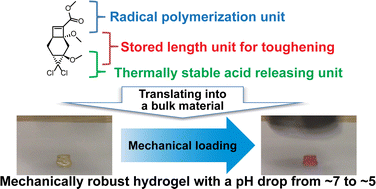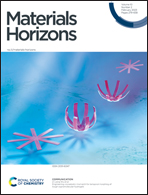Strain-triggered acidification in a double-network hydrogel enabled by multi-functional transduction of molecular mechanochemistry†
Abstract
Recent work has demonstrated that force-triggered mechanochemical reactions within a polymeric material are capable of inducing measurable changes in macroscopic material properties, but examples of bulk property changes without irreversible changes in shape or structure are rare. Here, we report a double-network hydrogel that undergoes order-of-magnitude increases in acidity when strained, while recovering its initial shape after large deformation. The enabling mechanophore design is a 2-methoxy-gem-dichlorocyclopropane mechanoacid that is gated within a fused methyl methoxycyclobutene carboxylate mechanophore structure. This gated mechanoacid is incorporated via radical co-polymerization into linear and network polymers. Sonication experiments confirm the mechanical release of HCl, and single-molecule force spectroscopy reveals enhanced single-molecular toughness in the covalent strand. These mechanochemical functions are incorporated into a double-network hydrogel, leading to mechanically robust and thermally stable materials that undergo strain-triggered acid release. Both quasi-static stretching and high strain rate uniaxial compression result in substantial acidification of the hydrogel, from pH ∼ 7 to ∼5.



 Please wait while we load your content...
Please wait while we load your content...
